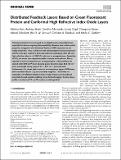Files in this item
Distributed feedback lasers based on green fluorescent protein and conformal high refractive index oxide layers
Item metadata
| dc.contributor.author | Karl, Markus | |
| dc.contributor.author | Meek, Andrew Thomas | |
| dc.contributor.author | Murawski, Caroline | |
| dc.contributor.author | Tropf, Laura Christine | |
| dc.contributor.author | Keum, Changmin | |
| dc.contributor.author | Schubert, Marcel | |
| dc.contributor.author | Samuel, Ifor David William | |
| dc.contributor.author | Turnbull, Graham A. | |
| dc.contributor.author | Gather, Malte Christian | |
| dc.date.accessioned | 2020-05-21T08:30:02Z | |
| dc.date.available | 2020-05-21T08:30:02Z | |
| dc.date.issued | 2020-06 | |
| dc.identifier | 267127359 | |
| dc.identifier | 71b233dc-567c-444d-8ddf-e801745aea81 | |
| dc.identifier | 85085056979 | |
| dc.identifier | 000534018800001 | |
| dc.identifier.citation | Karl , M , Meek , A T , Murawski , C , Tropf , L C , Keum , C , Schubert , M , Samuel , I D W , Turnbull , G A & Gather , M C 2020 , ' Distributed feedback lasers based on green fluorescent protein and conformal high refractive index oxide layers ' , Laser & Photonics Reviews , vol. 14 , no. 6 , 2000101 . https://doi.org/10.1002/lpor.202000101 | en |
| dc.identifier.issn | 1863-8880 | |
| dc.identifier.uri | https://hdl.handle.net/10023/19976 | |
| dc.description | Funding: European Research Council (ERC StG ABLASE, 640012). M.K. and A.M. acknowledge funding from the EPSRC DTG (EP/M506631/1 and EP/M508214/1). L.T. acknowledges studentship funding through the EPSRC CM-CDT (EP/L015110/1). M.S. acknowledges funding from the Royal Society (Dorothy Hodgkin Fellowship, DH160102). I.D.W.S. acknowledges funding from a Royal Society Wolfson research merit award. | en |
| dc.description.abstract | Fluorescent proteins have emerged as an attractive gain material for lasers, especially for devices requiring biocompatibility. However, due to their optical properties, integration with distributed feedback (DFB) resonators is not readily achievable. Here, a DFB laser with enhanced green fluorescent protein (eGFP) as the gain material is demonstrated by incorporating a thin (65 nm), high refractive index (n = 2.12) ZrO2 interlayer as waveguide core. Deposition of ZrO2 via atomic layer deposition yields a smooth and conformal film as required to minimize optical losses. Lasing emission is obtained from 2D second‐order DFB eGFP lasers at pump power densities above 56.6 kW cm–2 and a wavelength tuning range of Δλ = 51.7 nm is demonstrated. Furthermore, it is shown that in contrast to conventional organic DFB lasers, both transverse electric (TE) and transverse magnetic (TM) modes are accessible. The effective refractive index of these modes can be predicted accurately through optical modelling. Using far‐field imaging, the laser beam profile is studied and TE and TM modes are distinguished. | |
| dc.format.extent | 7 | |
| dc.format.extent | 882827 | |
| dc.language.iso | eng | |
| dc.relation.ispartof | Laser & Photonics Reviews | en |
| dc.subject | Biolasers, atomic layer deposition (ALD) | en |
| dc.subject | Distributed feedback (DFB) | en |
| dc.subject | Far-field mode analysis | en |
| dc.subject | Fluorescent proteins | en |
| dc.subject | Tunable lasing | en |
| dc.subject | QC Physics | en |
| dc.subject | QH301 Biology | en |
| dc.subject | T Technology | en |
| dc.subject | DAS | en |
| dc.subject.lcc | QC | en |
| dc.subject.lcc | QH301 | en |
| dc.subject.lcc | T | en |
| dc.title | Distributed feedback lasers based on green fluorescent protein and conformal high refractive index oxide layers | en |
| dc.type | Journal item | en |
| dc.contributor.sponsor | European Research Council | en |
| dc.contributor.sponsor | The Royal Society | en |
| dc.contributor.sponsor | The Royal Society | en |
| dc.contributor.institution | University of St Andrews. School of Physics and Astronomy | en |
| dc.contributor.institution | University of St Andrews. Centre for Biophotonics | en |
| dc.contributor.institution | University of St Andrews. Condensed Matter Physics | en |
| dc.contributor.institution | University of St Andrews. Sir James Mackenzie Institute for Early Diagnosis | en |
| dc.contributor.institution | University of St Andrews. Biomedical Sciences Research Complex | en |
| dc.identifier.doi | https://doi.org/10.1002/lpor.202000101 | |
| dc.description.status | Peer reviewed | en |
| dc.identifier.grantnumber | 640012 | en |
| dc.identifier.grantnumber | DH160102 | en |
| dc.identifier.grantnumber | NF171163 | en |
This item appears in the following Collection(s)
Items in the St Andrews Research Repository are protected by copyright, with all rights reserved, unless otherwise indicated.

